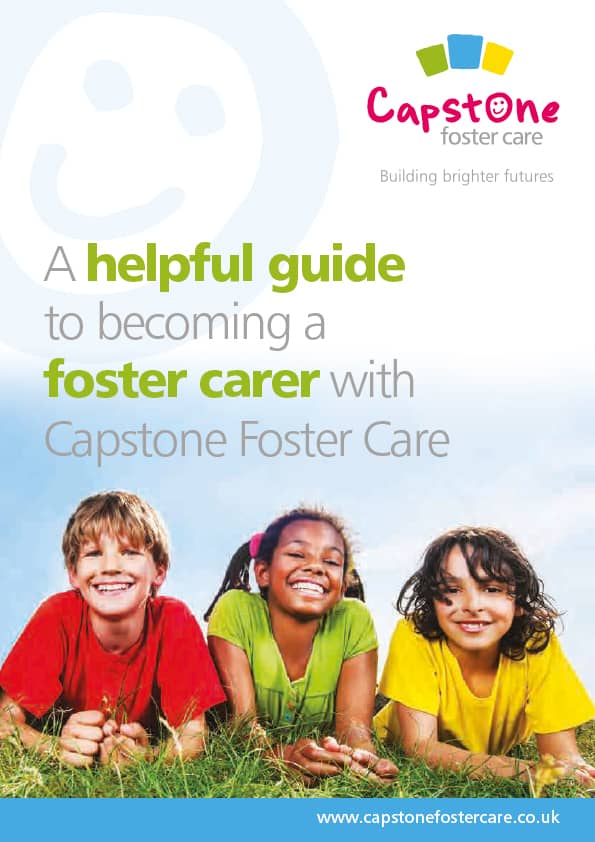


Fostering a disabled child
The role of an independent fostering agency
Can I choose who I foster?
How to foster
What are the benefits of fostering with an independent fostering agency?
What happens when a child is taken into care?
Fostering process: what happens on an initial home visit?
Can you foster if you have mental health issues?
Fostering with local authority vs independent agency
Interview: Life as a foster parent during the pandemic
Becoming A Foster Carer
Benefits of becoming a foster parent
What is a Care Leaver?
What is a Foster Carer?
What is Foster Care?
Do I become a Foster Carer?
Fostering Regulations
How much do Foster Parents get paid?
How to Foster a Child
How long does it take to become a Foster Carer?
How to foster – everything you ever wanted to know
Facts about Foster Care
What are the Foster Care requirements?
Foster Care Handbook
Foster Carer Job Description
Changing IFA - Transferring to Capstone
Fostering Definition
Foster Care Statistics
Fostering Assessment
Fostering Outcomes
Fostering Stories
Fostering Children UK
Children needing Fostering
8 reasons why a child may be taken into care
Fostering as a Career
Looked after Children
Top transferable job skills to become a foster carer
Fostering as a same sex couple
Fostering while renting
Can I foster if...?
Mythbusting the top 10 Foster Care Myths
Can I foster if I am disabled?
LGBT Fostering Mythbusting
Can I foster if I have pets?
Can I Foster A Child?
Can you Foster and Work?
Can you Foster with a Criminal Record
Fostering as a Single Parent
LGBT Family and Foster Care
Fostering across Cultures
Muslim Fostering
Christian Foster Care
Sikh
Empty Nest Syndrome and Foster Care
10 things you can do when your Children fly the nest
Can I Foster?
Fostering Babies - Myths
Focusing on Parent & Child Fostering
Fostering Siblings
Fostering Teenagers
Fostering Teenagers - Breaking down the Myths
Fostering Unaccompanied and Asylum Seeking Children
Mother and Baby Foster Placements
Private Fostering
Therapeutic Fostering - Multi-disciplinary Assessment Treatment & Therapy Service (MATTS)
Young Children Fostering Placements
Difference between short and long-term fostering
How to prepare a child for becoming a care leaver
Children who foster: impact of fostering on birth children
How to prepare your home for a foster child
10 tips for foster children’s education
How to prepare your foster child for secondary school
Tips for coping when foster placements end
Tips for foster parents during Coronavirus
What happens if foster parents get divorced?
5 ways to manage Mother’s Day with foster children
Tips for managing foster children’s bedtime routines
How to handle foster child bullying
Fostering allowances and the gender pay gap
Tips for keeping foster children safe online
How to adopt from Foster Care
5 ways to manage Father’s Day with foster children
8 most common fostering challenges
Supporting foster children’s contact with birth families
How to deal with empty nest syndrome
How to recognise signs of depression in foster children
Can you take a foster child on holiday?
Tips and advice on fostering with a disability
10 tips on connecting with your Foster Child
Fostering versus Adoption - What's the difference?
How Fostering can change a future
How to adopt from Foster Care
How to encourage children to read in Foster Care
How to prepare a Foster Child's bedroom
Online grooming - unwanted contact and how to identify it
Reading and storytelling with Babies and young Children
Supporting Children's Learning
Technology and Internet Safety advice
The 20 most recommended books Foster Carers and young people should read
The impact of early childhood traumas on adolescence and adulthood
Tips for coping with attachment disorders in Foster Children
Tips for supporting reunification in Foster Care
Together for a better Internet - Web Safety for Foster Children
What is sexual abuse and sexual violence
Foster Child behaviour management strategies
Foster Parent Advice: What to expect in your first year of fostering
Capstone's twelve tips at Christmas
10 celebrities who grew up in Foster Care
Celebrating our Children and Young People
Could Millenials be the solution to the Foster Care crisis?
Do you work in Emergency Services?
Form F Assessor and Assessment Training
Foster Care Fortnight
Improving Children's Welfare - Celebrating Universal Children's Day
It's time to talk about Mental Health and Foster Care
New Year - New Career - Become a Foster Carer
Promoting the rights and wellbeing of persons with Disabilities
Refugee Week
Young people and Mental Health in a changing world
Young People Charities
The goal of this special day is to inspire a “national conversation about using technology responsibly, respectfully, critically and creatively.” The theme is ‘together for a better internet.’ When it comes to keeping children and young people safe online, conversation is the key. The more that you can talk to children in your care about being online and being protected from harm, the better their internet experience will be.
The internet interaction with children in your home varies according to their age. It is a good experience when you see a small child manoeuvre the intricacies of a game on their tablet or laptop. How much trouble can they get into, playing a simple game designed for young children, you ask yourself. Learning to handle technology is a positive thing, isn’t it?
The reality is that the internet is a powerful force in today’s society, both for good and for bad. Here are the primary dangers that can be encountered online.
When an adult uses the anonymity of the internet to strike up a dialogue with a child, they are able to pose as a friendly person of a similar age to the child. When a youngster feels that he or she is talking to another child, they are willing and eager to share information such as their name and address. While this may not be a problem for a three year old, when a child is able to read and respond to online messages, they can be encouraged to meet their new friend face to face and the outcome of such a meeting can be disastrous.
This form of bullying may be worse than face to face bullying because there is no way to escape it. It extends into the centre of your home and is there any time the child is online. Cyberbullying can gain strength on social networks when the bully recruits his or her friends to engage in bullying your child. It can be an extension of offline bullying in the child’s peer group and it can destroy a child sense of dignity, security, and wellbeing.
It is very easy for kids to share their lives on social media or to send text messages with inappropriate images. Once a post is made or message sent, the information can become public. It can also remain online for a very long time, cropping up in later years with long-term repercussions.
Even if the message or image is only intended for a friend, it is very easy for that information to end up in the wrong hands. It is especially important for children to know that they should never take inappropriate pictures of themselves and even more important that they don’t share it.
Apps and games are usually safe and fun to play and have age restrictions. The biggest problem is that they can be a way for online predators (groomers) to reach children and gather a great deal of personal information about them.
There are other, less obvious safety risks online. With the overwhelming amount of information flowing into your child’s life, the internet provides a source of promotion of harmful behaviours, such as suicide, self-harm, and drug abuse.
Peer pressure online can contribute to unrealistic body image notions. This is compounded by beauty videos and celebrities on social media. The latest looks and fashion can make a young person learn to hate the way they look.
Another is the preponderance of false information. When children believe some of the false information they see on social media, they can get into trouble. What they see or read can cause them to have their identity stolen or be blackmailed because they shared explicit images.
The dark web is real, and it is a marketplace for illegal transactions. It is possible to buy guns and drugs on the dark web. It is also a hub for human trafficking and child pornography.
With the ease of contact through email and online networking sites, contact with widespread families is easier than it has ever been. While ensuring online security and safety is a must for parents, as foster parents, you have another online concern. The ease of making contact also makes it easier for cared for children to keep in touch with their birth families. A child’s care plan outlines how contact between children and their families should be arranged and such decisions are made with the child’s well-being in mind. With current technology, foster carers have a real challenge in regulating how such contact is managed.
Keep a vigilant eye out for changes in behaviour. It is very easy for a child to fall into a situation online where they are being bullied or lured into a clandestine communication with a groomer. They can be traumatised by sexually explicit or violent images. In these situations, the child may display changes in behaviour because they are keeping a secret about an online friendship or they are frightened, for instance.
There is another insidious problem called the fear of missing out, often referred to as FOMO. With the immediacy of social networks, a child might end up constantly checking their online accounts for late-breaking posts. They feel compelled to know exactly what their friends (and enemies) are doing at that very moment.
Watch for signs of a persistent need to be checking their phones. FOMO can lead to internet addiction that can cause them to be distracted. Keeping in obsessive touch with their online world affects their studies, their interaction with family, and their participation in the real world.
Keeping your children safe online begins with communication and awareness. Once you know what dangers are out there and what to look for, you are ready to become proactive in protecting children from internet pitfalls. If you pay attention to what they do and where they go online and are aware of how and why they use the web, you are ahead of the game.
Talk to them about the benefits of the internet and keep a positive attitude toward being online. This way, they will feel confident in their ability to talk to you about the reality of the internet because you have made it clear that you are not totally against the internet and just trying to ruin their fun with rules.
Most social media sites provide controls for privacy and security controls so you and your child can control the type of content they can access online. You need to set the content controls on the household computer as well as any personal devices your children use. Doing this before they see explicit content or encounter dodgy people is easier than trying to overcome any issues such events can cause.
Look out for apps that allow others to tag your children in images and comments. They can too easily be tagged in offensive and hurtful online posts. There are tagging settings that can prevent this from happening. Something else to check is whether their apps have geo-location enabled. This can provide your exact address to strangers without your child explicitly providing the information.
When the National Fostering Agency (NFA) provides guidance on internet safety for children aged 3 to 7, it is a good indication that it is never too early to start awareness of the choices we need to make to remain safe in the technological world of the internet.
Begin by talking to these little ones about what apps they use and what websites they like to visit. Don’t make a big deal of it. Find out what they like about these apps and sites and ask them to show you around them. It’s a good time to set privacy controls, and let the kids know why they need them. It’s non-confrontational and a good teaching moment.
There are several recommendations for online safety that apply to children of all ages. They are good recommendations for adults as well.
Specifically, for children in the 3-7 age bracket, they should be taught to choose to:
1. Make good choices online
There are many choices to make. Kids should learn to check with an adult before choosing what game to play, what messages they should reply to, what buttons to click.
2. Ask if it’s okay
Teach your little ones to check before they do something online that could affect other people. They should know that it is important to respect others when they say that it is not okay to do something online that they don’t want you to do.
3. Keep personal information safe online
Teach them to safeguard personal information online and always check with an adult before sharing information. It is important that they know they should not tell anyone asking online their full name, where they live and where they go to school. If anyone asks for this kind of information, they should tell an adult. Meeting someone offline that they only met online can be dangerous.
4. Find out more
When a child signs up for games, they can be asked for information about him or her. Teach them to find out more about why this information is needed. Teach them to check with an adult first.
5. Ask for help
Let children know that they should tell an adult about anything online that worries them or that they don’t understand.
For children between 7 and 11, there are a few more suggestions. As well as choosing sensible choices, asking if it’s okay, and asking for help, they should also choose to:
1. Be aware
It is important that they know the rules of behaviour and how to stay safe on the sites they visit and in the games they play. They should know how to block and report others on their sites if they are misbehaving.
2. Be a role model
Help children learn how to be kind and supportive to others online. Teach them to share what they have learned about blocking offensive people and talking to a trusted adult about concerns they have.
Older children, aged 11 to 18, should learn to make the following choices:
1. Ask for consent
They should never share information about others without asking permission first.
2. Be in control
Check the privacy settings of social accounts online. It’s a good idea to choose what is shared publicly.
3. Find out more
Check how your information is being stored and used by the apps used. When you sign up for an app, there are terms and conditions and young people need to be aware of what they are agreeing to.
4. Talk about it
If you are ever not sure how to handle a situation online, talk to a trusted adult. There are helplines you can check with, such as Childline and The Mix.
There is always ongoing training available and when it comes to technology, there are always changes. Apps need to be updated, and your computer’s operating system needs to be updated. Smart phones always seem to be prompting you to install the latest updates. Take the technology’s advice on updates. There is a constant improvement in security controls.
As a foster parent, there are many things to learn. When there is a new young person in your home, there are often adjustments as you get to know each other. You don’t want to impose your household online rules without talking to them first about why you have parental controls on computer and phone use.
Your communication about being online might be old hat to your children because you have been talking with them about it for a while. Your communication with your foster children needs to be open, non-confrontational, and laced with some humour and gentleness. Internet addiction, as noted, may develop from FOMO. For a child in a new environment, this can be exacerbated by a need to cling to the online world they have created.
Also, until you know a child’s ability with a phone and the online world, you are not able to understand their technical expertise. Some children can astound you with their technological expertise. If you become comfortable with technology and are able to communicate easily with young people about it and let this conversation be a background to being online, internet safety will become a part of the fabric of their lives. It is all about working together for a better internet.
If you’ve got any questions or would like to find out more about fostering with Capstone, fill out the form below.
An experienced fostering advisor from your local area will then be in touch.

Start the conversation today. Our team of friendly advisors are on hand to answer any foster care questions you may have. We can offer you honest and practical advice that can help you decide if becoming a foster carer is the right path for you.


